
Waved Woodpecker
Celeus undatus
Piciforme Order – Picidae Family
BIOMETRICS:
Length: 23-24 cm
Weight: M : 60-73 g – F : 58-68 g
DESCRIPTION:
Waved Woodpecker is a member of genus Celeus which gathers the woodpeckers of Central and South America living in tropical and subtropical forests and woodlands.
Fr: Pic ondé
All : Olivbürzelspecht
Esp : Carpintero Ondoso
Ital: Picchio ondulato
Nd: Geschubde Specht
Port: Pica-pau-barrado
Photographers :
Marc Chrétien :
MURINUS
Patrick Ingremeau
TAMANDUA
Maxime Dechelle
LEPAPARRAZO
Text by Nicole Bouglouan
Sources :
HANDBOOK OF THE BIRDS OF THE WORLD Vol. 7 by Josep del Hoyo-Andrew Elliott-Jordi Sargatal – Lynx Edicions – ISBN: 8487334377
BirdLife International (BirdLife International)
Wikipedia (Wikipedia, The Free Encyclopedia)

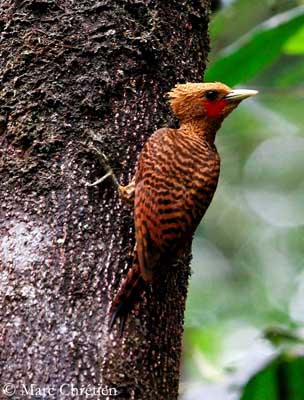
Adult male has chestnut-rufous upperparts broadly barred black. Rump may be paler or yellower.
On the wings, flight feathers are black with pale rufous bars.
Uppertail feathers are black too with some rufous bars, sometimes none.
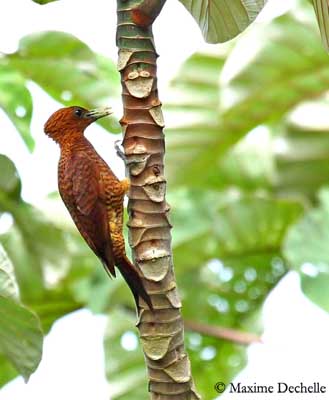
Underparts are rufous-yellow, broadly barred black. Breast shows irregular wavy bars. Belly and flanks are more regularly barred. The lower underparts are paler.
Underwing is cinnamon with barred flight feathers’ bases.
Undertail is similar to uppertail, but slightly duller, even yellowish.
The head is light chestnut-rufous with paler crown and crest, often barred. The rear ear-coverts and neck sides are finely spotted or streaked. We can see a bright red band from the bill base to the ear-coverts, just below the eye.
Chin and throat are dark cinnamon spotted or barred black.
The bill is relatively short and dull yellow to yellow-green. Eyes are red-brown or red. Legs and feet are greenish-grey.
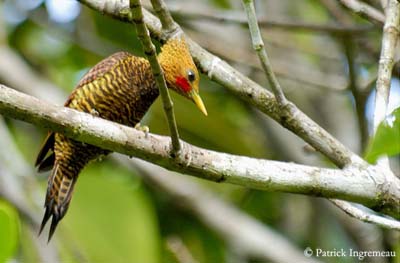
Female is similar, but she lacks the red patch on the head side, and her plumage is more heavily barred.
Juvenile is duller and less barred on the upperparts.
There is great variation in the black barring. The Brazilian birds show heavier barring, and the upper breast is sometimes almost black. The red malar patch may be larger too.
We find three subspecies:
C.u. undatus
C.u. amacurensis is darker and more chestnut, with narrower bars.
C.u. multifasciatus is bigger than others with shorter tail and paler plumage overall.
VOICE: SOUNDS BY XENO-CANTO
Waved Woodpecker gives loud “wit-koa”. We can also hear a soft “kowahair” as a whisper rising in pitch.
Male and female drum.
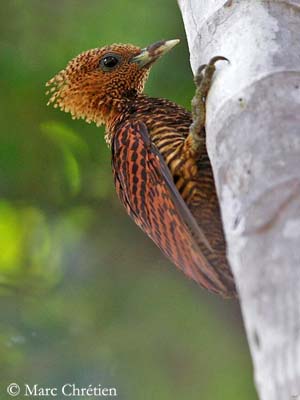
HABITAT:
Waved Woodpecker frequents dense rain forest up to 500 metres of elevation.
This species may also be seen in more open areas in savannahs, at forest edges and near streams.
RANGE:
Waved Woodpecker is found in the Guyana, Suriname and French Guiana, E Venezuela, NE Amazon Basin of N Brazil.
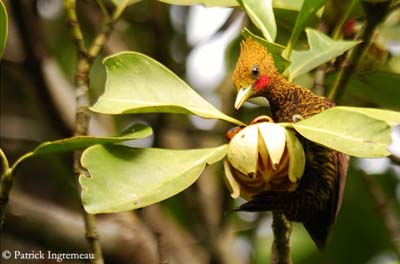
BEHAVIOUR:
Waved Woodpecker often forages in treetops where it is difficult to see it. It feeds on ants and termites, and sometimes seeds and fruits.
It may occasionally join mixed foraging flocks.
The Celeus woodpeckers frequently roost in fruit trees. They are diurnal birds and leave the roost-hole at sunrise for feeding, preening and resting in midday. They return to the roost for the night.
Waved Woodpecker is resident in its range.
FLIGHT:
Waved Woodpecker has undulating flight performed with wing beats followed by glides.
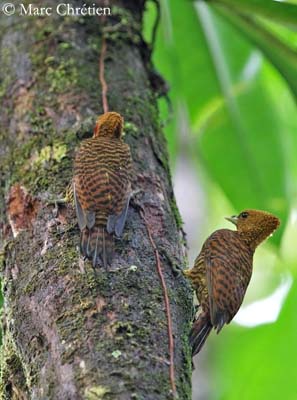
REPRODUCTION:
Breeding season occurs from late may to August in the Guianas, probably earlier in SE of the range.
The nest is a hollow in tree. It is excavated by both mates in dead or live tree, between 4 and 30 metres above the ground.
No more available information.
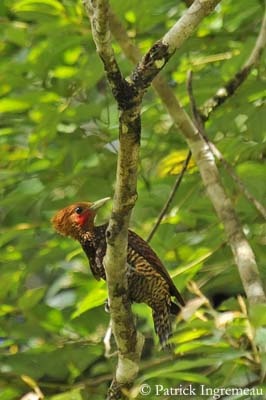
DIET:
Waved Woodpecker feeds mainly on ants and termites, some seeds and fruits.
PROTECTION / THREATS / STATUS:
Waved Woodpecker is a poorly known woodpecker and an uncommon species. It can be seen in national parks and reserves in Venezuela, and in French Guyana in Mana.
This species lives in dense forests, making difficult to observe them and to determine the population status.